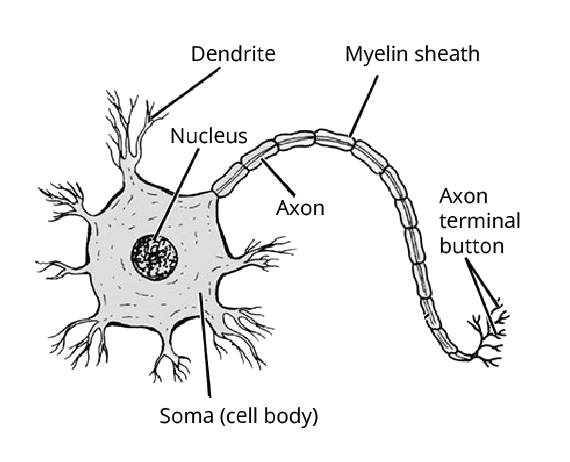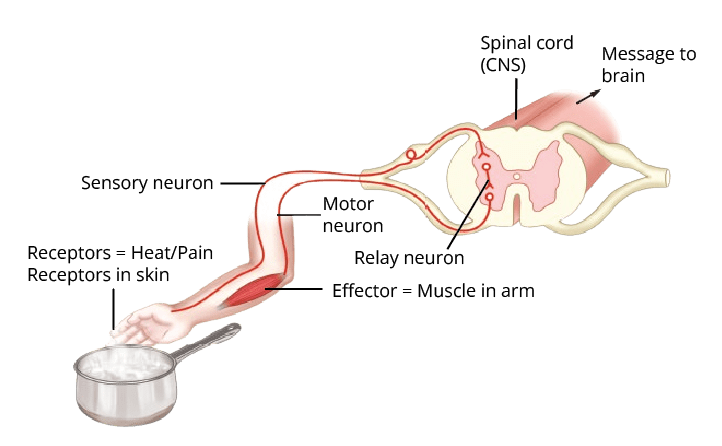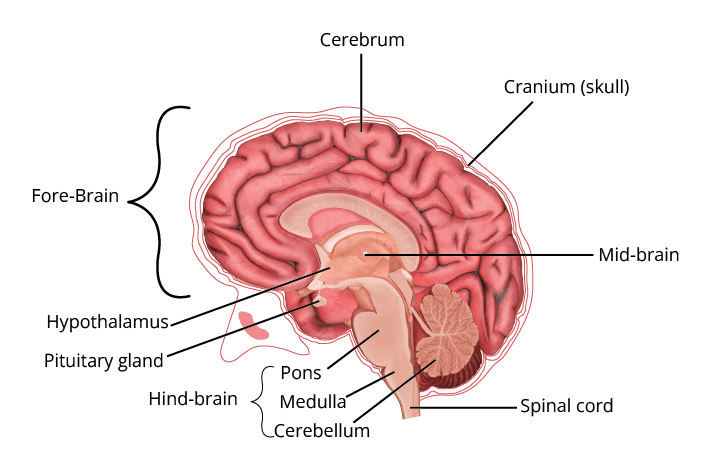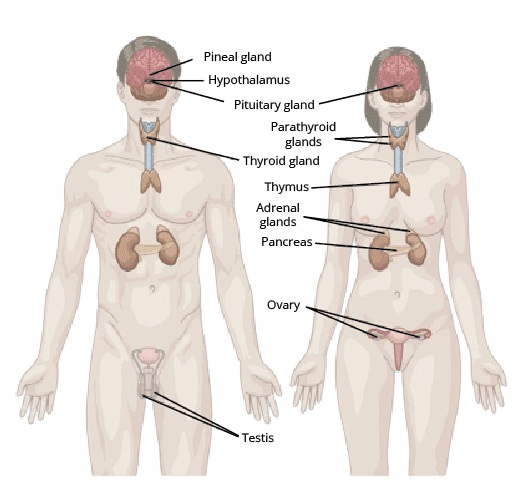Class 10 Control and Coordination Notes FREE PDF Download
Chapter 6 Control and Coordination Class 10 Notes provides a comprehensive guide. This FREE PDF download provides detailed important highlights of the chapter important for exam preparation. It gives insight into how living organisms respond to stimuli through various mechanisms. This chapter covers topics such as the nervous system, animal hormones, and plant movements. Vedantu's Class 10 Control And Coordination Revision Notes offer clear explanations and guidance, ensuring students easily grasp these vital concepts.
 Table of Content
Table of ContentDownload the FREE PDF of Class 10 Science Revision Notes prepared by Vedantu Master Teachers and updated according to the CBSE Class 10 Science Syllabus, and start your journey toward academic success with Vedantu!
Control and Coordination Class 10 Notes: CBSE Science Chapter 6
Access Class 10 Science Chapter 6 - Control and Coordination Notes
Animals - Nervous System
Function: Controls and coordinates body actions through the brain, spinal cord, and nerves.
Role: Sends, receives, and processes messages as chemical signals (impulses).
Structure: Composed of a network of nerve cells (neurons) that transmit information via electrical impulses.
Neuron Components:
Cell Body (Cyton): Contains the nucleus.
Dendrites: Branched projections that receive signals.
Axon: Long process that sends signals away from the cell body.

A synapse is a connection between two neurons.
Nerves are strands of tissue that emerge from the brain and spinal cord. Nerves are crucial for conveying messages throughout the body and branch out to all regions of the body.
Nerve cells or neurons come in a variety of shapes and sizes.
The brain or spinal cord receives messages from the sense organs via sensory nerves.
Motor neurons transmit messages from the brain or spinal cord to all of the body's muscles and glands.
Interneuron or relay neuron is a type of neuron that connects neurons in different parts of the central nervous system.
What Happens in Reflex Actions?
Definition: An automatic and immediate movement in response to stimuli.
Function: Occurs as a quick reaction to environmental changes.
Reflex Arc: The pathway involved in reflex actions, where sensory neurons synapse in the spinal cord before reaching the brain.
Efficiency: Reflex arcs enable faster responses by bypassing the brain, resulting in quicker reactions.

Human Brain:
Types of the Nervous System
The central nervous system and the peripheral nervous system are the two parts of the nervous system.
Central Nervous System:
The brain and spinal cord are part of the central nervous system. It receives data from the body and transmits instructions to certain organs.
The forebrain, midbrain, and hindbrain are the three major portions or areas of the brain.
The forebrain is the region of the brain that is responsible for thinking. The cerebrum and diencephalon make up this structure.
Memory and intelligence, as well as sense centres such as hearing, smell, and sight, are all housed in the cerebrum. The diencephalon is where pressure and discomfort are stored.
The midbrain connects the forebrain to the hindbrain and regulates vision and hearing reflexes.
The cerebellum, pons, and medulla make up the hindbrain. The cerebellum is responsible for coordinating muscle actions as well as maintaining balance and posture.
The medulla is in charge of involuntary functions such as blood pressure, salivation, vomiting, and heart rate.
The spinal cord is protected by the vertebral column or backbone and extends from the medulla of the brain through the entire length of the vertebral column.
Peripheral Nervous System:
The cranial and spinal nerves emerge from the brain and spinal cord, respectively, to form the peripheral nervous system.

What Safeguards are in Place for the Tissues?
The brain is protected by the sturdy bones of the skull, as well as a fluid called cerebrospinal fluid, which absorbs additional shock.
What is the Mechanism by Which the Nervous System Causes Action?
Muscle fibres must move when a nerve impulse reaches them. Muscle cells will shorten as a result of their changing form. Special proteins in muscle cells change their form and arrangement in the cell in response to nerve electrical signals. When this happens, the muscle cells take on a new shape as a result of new protein groupings.
Plant Coordination: All living organisms react to their surroundings. Chemicals released by cells help plants respond to stimuli as well. Plants, like all living beings, move about. Plants have two types of movement: one that is dependent on growth and the other that is not.
Plants also use electrical and chemical mechanisms to transmit information from cell to cell, but there is no dedicated tissue for information transmission in plants. Plants slowly respond to stimuli by growing in a specific direction. Because of the directional growth, the plant looks to be moving.
Directional Movements: Tropic movements are also known as directional movements. These movements can be either toward or away from the stimuli.
Positive Phototropism: Shoots bend towards light.
Negative Geotropism: Shoots grow away from the earth.
Negative Phototropism: Roots bend away from light.
Positive Geotropism: Roots grow towards the ground.
Hydrotropism: Growth response to water stimuli.
Chemotropism: Movement in response to chemicals.
Thigmotropism: Movement in response to touch, with positive thigmotropism moving towards touch and negative thigmotropism away from touch.
Pollen Tubes: Grow towards ovules.
Auxins: Promote cell elongation and shoot apical dominance.
Gibberellins: Stimulate stem growth, seed germination, bolting, and blooming.
Cytokinins: Encourage cell division and stomata opening.
Abscisic Acid: Slows growth, closes stomata, and can cause leaf wilting.
Animal Hormones: The endocrine system is made up of ductless glands that emit chemical compounds known as hormones. Hormones are released directly into the bloodstream by endocrine glands.
Hormones are chemical messengers that are injected into the bloodstream and act on specific organs.

Endocrine Glands
The pituitary gland, the pineal gland, the hypothalamus, the thyroid, the parathyroid, the thymus, the adrenal gland, the pancreas, the testes, and the ovary are all examples of endocrine glands.
Adrenal Glands:
Adrenal glands are found above the kidneys. The adrenal cortex and adrenal medulla are two parts of the adrenal gland.
The adrenal cortex secretes cortisol, aldosterone, and androgens, while the adrenal medulla secretes adrenaline and noradrenaline. Adrenaline is sometimes known as the "fight or flight" hormone or the "emergency hormone." It prepares the body to deal with physical stress in an emergency situation, such as danger, anger or excitement.
Thyroid Gland:
The thyroid gland is one of the largest endocrine glands in the body, and it is positioned in the neck, ventral to the larynx.
Triiodothyronine and thyroxine are the main hormones generated by this gland. Thyroxine is a hormone that controls the body's glucose, protein, and fat metabolism. Iodine is required for the production of thyroxin. Goitre is caused by a lack of iodine in the diet. A swollen neck is one of the signs of this condition.
Pituitary Gland:
The pituitary gland is a master gland that secretes several hormones to regulate the organs as well as the other glands. It is located near the base of the brain.
Growth hormone, TSH, FSH, LH, ACTH, MSH, Vasopressin, and Oxytocin are among the hormones released by this gland. Growth hormone is a hormone that controls the body's growth and development. Dwarfism is caused by a lack of this hormone throughout childhood. Gigantism is caused by the excessive release of this hormone.
Gonads:
Female gonads and male gonads are the two types of gonads found in humans.
Female Gonads:
Oestrogen and progesterone are two hormones produced by the ovaries.
Oestrogen regulates puberty-related changes such as feminine voice, soft skin, and mammary gland development; progesterone regulates uterine changes during the menstrual cycle and aids in the maintenance of pregnancy.
Male Gonads:
In males, a pair of testes constitutes the gonads.
A pair of testes is the male sex organ placed outside the abdomen in the scrotum.
The hormone testosterone is produced by the testes.
Testosterone regulates the changes that occur throughout puberty, such as a deeper voice, the development of the penis, and the growth of facial and body hair.
The Pancreas:
The pancreas is found just below the stomach, within the duodenum's curvature. Its role is both exocrine and endocrine. Insulin, glucagon, somatostatin, and pancreatic polypeptide are among the hormones secreted by the pancreas.
Insulin is a hormone that controls the amount of sugar in our blood. Insulin secreted in little amounts raises blood sugar levels, resulting in diabetes mellitus.
The Pineal Gland:
The pineal gland generates the hormone melatonin and is located towards the centre of the brain, dorsal to the diencephalon.
Melatonin has an impact on reproductive development, wake and sleep pattern modulation, and seasonal functions.
The Hypothalamus:
The hypothalamus is a neuro-endocrine region of the brain that connects the neurological and endocrine systems via the pituitary gland, which secretes hormones like Somatostatin and Dopamine.
Parathyroid Glands:
Two pairs of small oval-shaped glands embedded on the dorsal surface of the thyroid gland in the neck are known as parathyroid glands.
They secrete a hormone called parathormone. It aids in calcium and phosphate ion control in the bones and blood.
Tetany is caused by hyposecretion, while osteoporosis is caused by hypersecretion.
The Thymus Gland:
The thymus gland is located in the upper region of the sternum, in front of the heart, and generates the hormone thymosin. It also aids in the maturation of T-lymphocytes.
The hormone testosterone is produced by the testes.
Feedback systems control the timing and amount of hormones released. For example, when blood sugar levels rise, the pancreatic cells sense it and respond by creating more insulin. Insulin secretion decreases when blood sugar levels fall.
The Nervous System
The nervous system works with multiple organs coming together to transfer the electric signals from the brain to the other parts of the body. The neurons present in the nervous system work as a functional and structural unit of the nervous system.
Neuron
Neurons constitute three main parts, namely dendrites, Cyton, and Axon. The work of dendrites is to receive the impulses from the other neurons. The Cyton will process the impulse which dendrites have taken. Once the Cyton processes the impulse, Axon switches the impulse to another neuron or the muscle and glands, depending on the requirement.
Lastly, the Axon is of two types, the first one is myelinated, and the other one is non-myelinated. The transfer of the impulse will be faster in the myelinated neurons.
Different Parts of the Brain and their Importance
Cerebrum: It is responsible for reasoning, logic, emotions, speech, memory, auditory and taste stimuli, etc. if this part of the brain doesn't work correctly, the individual might not be able to hear or speak.
Cerebellum: We know these words may sound similar to students, but they are named after different brain parts. The cerebellum is responsible for the body's movements, such as walking, running, sitting, posture, and balance.
Pons: This is the brain's relay network, which helps in transferring signals from the hindbrain to the forebrain parts.
Medulla Oblongata: This part of the brain controls all the involuntary movements which our body does. The vomit you feel, the sneeze you make, along with the yawn which you take all of it is regulated by the Medulla Oblongata.
- This part of the brain will also continue to the spinal cord, which follows the vertebral column and controls all the reflex actions that the human body does.
Different Types of Nervous System in Class 10 Science Chapter 6 Notes
In Class 10 Chapter 6 science notes, we learn about three different types of nervous systems, and all of them are explained in detail in this section.
Central Nervous Systems (CNS)
The notes of Chapter 6 Science Class 10 from Vednatu describe adequately how the CNS, the part of our human body, is made from the spinal cord and brain.
The CNS is protected by 3 main layers:
The bony skull (cranium)
The cerebrospinal fluid
The meninges (Dura mater, Arachnoid and Pia mater)
Peripheral Nervous System
These are the nerves that are given out by the brain and the spinal cord for the human peripherals to work and coordinate with the brain. This nervous system contains 12 cranial nerves along with 31 spinal nerves.
Somatic Nervous System
The somatic nervous system can be found in some parts of the Peripheral nervous system. It is made from the nerves, which are responsible for the control of all the voluntary actions.
Autonomic Nervous System
The last nervous system in notes of control and coordination Class 10th is ANS. All the nerves responsible for the human body's involuntary actions are combined to form an autonomic nervous system.
The ANS is divided into two parts, which are the sympathetic and parasympathetic nervous systems.
The sympathetic part of the ANS prepares the body for the intense physical activity that the body is about to do.
- It is often the system responsible for the fight-or-flight decision-making.
Synapse
Synapse is the neuronal junction, a site where the two neurons change their information through the electric impulse or a bridge between a neuron cell and the human gland or muscle. Without the presence of Synapses in the neuron and the muscles of a human body won't transfer and receive electrical impulses. As a result, the muscle movement will not take place, and it will remain in the same state forever.
Reflex Action
When a football is coming with a high speed right at you, you duck yourself and let the football pass over you. You do it without even thinking twice, well, that's what the reflex action is, and that's how it protects you from sudden accidents and injuries. According to Chapter 6 science Class 10 notes, a reflex action is a sudden action performed by the body in response to the stimuli. The path used for the electrical impulse to serve the reflex action is called a reflex arc.
On the other hand, the parasympathetic nervous system works in the complete opposite way. Thus, it makes your body feel relaxed and slows down many high functioning parts of your body.
Important Topics of Class 10 Chapter 6
Detailed Structure of Topics Covered:
Topics | Subtopics |
Animals – Nervous System |
|
Coordination In Plants |
|
Hormones In Animals |
|
Important Points of Class 10 Chapter 6 Control and Coordination
Nervous System
Central Nervous System (CNS): Comprises the brain and spinal cord.
Peripheral Nervous System (PNS): Consists of nerves that connect the CNS to the rest of the body.
Neurons are the basic units of the nervous system responsible for transmitting impulses.
Reflex Action: Involuntary and rapid response to a stimulus.
Brain Structure and Function
Cerebrum: Controls voluntary actions, intelligence, memory, and senses.
Cerebellum: Maintains balance and coordinates muscular activities.
Medulla Oblongata: Regulates involuntary actions like breathing and heart rate.
Endocrine System:
Hormones: Chemical messengers secreted by endocrine glands.
Pituitary Gland: The "master gland" that controls other endocrine glands.
Thyroid Gland: Produces thyroxine, which regulates metabolism.
Pancreas: Produces insulin, which controls blood sugar levels.
Adrenal Glands: Produce adrenaline, which helps the body respond to stress.
Coordination in Plants:
Tropism: Directional movement responding to a stimulus (e.g., phototropism, geotropism).
Nastic Movements: Non-directional responses to stimuli (e.g., touch response in Mimosa).
Plant Hormones: Auxins, gibberellins, cytokinins, abscisic acid, and ethylene regulate growth and responses.
Importance of Revision Notes for Class 10 Control and Coordination
Vedantu’s Revision Notes for Class 10 Science Chapter 6, "Control and Coordination," provides in-depth explanations of essential concepts such as the nervous system, hormones, and reflex actions, ensuring a comprehensive understanding of how organisms control and coordinate their activities.
It offer detailed and step-by-step solutions that simplify complex processes involved in the nervous and endocrine systems.
Class 10 Science Ch 6 includes diagrams and illustrations that make learning about neurons, synapses, and different glands more visual and easier to understand.
This Notes aligns with the CBSE curriculum, ensuring that students cover the topics and concepts required for their academic year.
Vedantu also offers additional study materials such as class notes, important concepts, and exemplar solutions to reinforce learning and ensure a solid grasp of the subject matter.
Tips for Learning the Class 10 Science Chapter 6 Control and Coordination
Focus on core processes with illustrations and examples.
Draw and label diagrams for clarity.
Create brief summaries of each process.
Connect concepts to everyday examples.
Solve past exam questions to test understanding.
Explain concepts to others to reinforce learning.
Revisit material frequently to retain information.
Utilise platforms like Vedantu for additional support.
Conclusion
Vedantu’s Class 10 Control And Coordination Revision Notes assist students in understanding this crucial topic easily. Focusing on concepts like the nervous system, reflex actions, and hormones is important, as they play key roles in controlling and coordinating our body's functions. With clear explanations and step-by-step solutions, students can grasp these concepts effectively. Previous year question papers typically include around 5-7 questions from this chapter, emphasising the significance of thorough preparation. By using Vedantu’s Revision Notes, students can enhance their understanding, boost their confidence, and excel in their examinations
Related Study Materials for Class 10 Science Chapter 6
S. No | Important Study Materials Links for Chapter 6 Control and Coordination Class 10 |
1. | |
2. |
Revision Notes Links for Class 10 Science Chapter 6
You can also access chapter-wise Revision Notes for Class 10 Science from the links below and kick-start your preparation for Class 10 Board exams.
S. No | CBSE Class 10 Revision Notes Links |
1 | |
2 | |
3 | |
4 | |
5 | |
6 | |
7 | |
8 | |
9 | |
10 | |
11 | |
12 |
Important Study Materials for Class 10 Science
S. No | Important Links for Science Class 10 |
1. | |
2. | |
3. |
FAQs on Control and Coordination Class 10 Notes: CBSE Science Chapter 6
1. What are Control and Coordination Class 10 Notes?
Control and Coordination Class 10 Notes provide a summary of the key concepts related to the nervous and hormonal systems in organisms. They cover topics like coordination in plants and animals, including responses to stimuli.
2. Where can I find Class 10 Control and Coordination Notes?
Class 10 Control and Coordination Notes can be found on Vedantu website. They offer detailed insights into the chapter, helping students understand and revise effectively.
3. What do Control and Coordination Notes include?
Control and Coordination Notes include summaries and explanations of the mechanisms of control and coordination in living organisms. They cover both plant and animal responses, focusing on the nervous and hormonal systems.
4. How can I download Control and Coordination Class 10 Notes PDF?
Control and Coordination Class 10 Notes PDF can be downloaded for free from Vedantu website.
5. What is covered in Class 10th Science Chapter 6 Notes?
Class 10th Science Chapter 6 Notes cover the topic of control and coordination. They include information on the nervous system, hormonal control, and responses to stimuli in plants and animals.
6. Where can I find Class 10 Science Ch 6 Notes?
Class 10 Science Ch 6 Notes, which focus on control and coordination, are available on various educational websites and revision guides. These notes help in understanding the chapter's key concepts.
7. What are the key topics in Control and Coordination Class 10 Notes?
Key topics in Control and Coordination Class 10 Notes include the structure and function of the nervous system, hormones, and how plants and animals respond to stimuli.
8. How do Class 10 Control and Coordination Notes help with exam preparation?
Class 10 Control and Coordination Notes help with exam preparation by summarising essential concepts, making it easier to revise and understand the material needed for exams.
9. Where can I get the Control and Coordination Class 10 Notes PDF?
You can get the Control and Coordination Class 10 Notes PDF from Vedantu website that offer free downloads of study materials. These PDFs provide a detailed overview of the chapter.
10. What does Class 10 Science Chapter 6 Notes include?
Class 10 Science Chapter 6 Notes include comprehensive information on control and coordination, covering both the nervous and hormonal systems, as well as plant responses to stimuli.














 Watch Video
Watch Video













